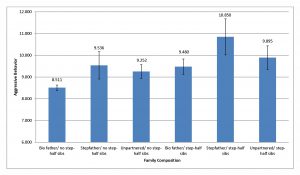
Aggressive behavior more common in children with half- and step-sibs
January 26, 2016

Photo credit: Thinkstock
ANN ARBOR—About one in six U.S. children – more than previously thought – live with half- or step-siblings just before starting kindergarten, according to a new study. And these children behave aggressively more often, on average, than do other children.
Much previous research on how family complexity affects children’s development has focused on the union status of parents, and their relationship to the child. But according to Paula Fomby, a sociologist at the University of Michigan Institute for Social Research (ISR), most young children in complex sibships live with both of their own biological parents or with a single mother, not with step-parents.
The role of sibling relationships has received less attention, even though siblings are often a child’s most important peer relationships.
Fomby is the first author of an article on family complexity, siblings, and children’s aggressive behavior at school entry forthcoming in the February issue of Demography, a peer-reviewed journal. The research was supported by a grant from the National Science Foundation. Fomby’s co-authors are Joshua A. Goode and Stephanie Mollborn, both at the University of Colorado at Boulder.
For the study, the researchers analyzed data from a nationally representative sample of approximately 6,500 U.S. children and their families from the Early Childhood Longitudinal Study.
Each young child’s primary parent, usually the biological mother, reported on how often the child displayed aggressive behavior at the age of 5. This included temper tantrums, physical aggression, destruction of others’ property, and shows of anger. Heightened aggression in young children suggests a lack of school readiness.
Parents’ union status and the presence of step- or half-siblings operated independently in predicting children’s aggressive behavior, the researchers found. But on average, children living with step- or half-siblings had aggressive behavior scores in kindergarten that were about 10 percent higher than peers whose parents had the same union status but no step-/half-siblings in the household.

Click to enlarge.
In addition to parents’ union status, Fomby and colleagues took many factors into account to explain the heightened levels of aggression in these children. Among the factors were material resources and mothers’ parenting styles. But the reason for the link between complex sibships and more frequent aggressive behavior remained elusive.
Other potential explanations might include the developmental timing of when step- and half-siblings enter a child’s household and the potentially uneven distribution of material and emotional resources to each child within a family.
Another factor could be parental absence, Fomby suggests. “Across family structures, all children living with a step- or half-sibling have one thing in common: at least one child in the household has an absent biological parent, either living elsewhere or no longer living,” she says. “Prior work has shown that having an absent parent, and particularly an absent father, is associated with a higher risk of aggressive behavior in younger children. In future work, we plan to consider how the behavior of children with an absent parent might impact other children in the household for whom both parents are present.”
Contact: [email protected]
By Diane Swanbrow
